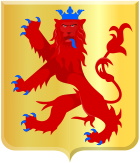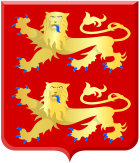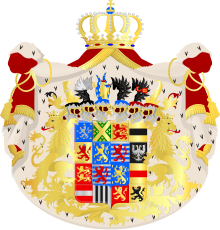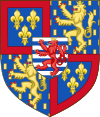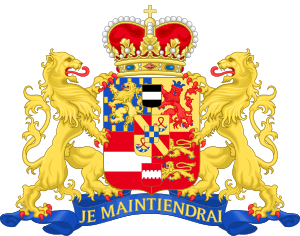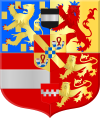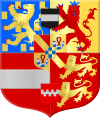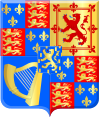| This article needs editing to comply with Misplaced Pages's Manual of Style. Please help improve the content. (January 2020) (Learn how and when to remove this message) |
This page shows the coats of arms, heraldic achievements, and heraldic flags of the House of Nassau.
Also included in the royal family section are the flags of the Dutch royal family. While not strictly a heraldic flag or a banner of arms, they are heavily influenced by heraldry. Flags of those born into the royal family feature a Nassau-blue cross on an orange field, while the colors are reversed for those who marry into the family. The males have near-square flags while those of females are swallowtailed. Elements of an individual's family coat of arms are also incorporated into the flags.
Overview of Nassau arms
Background and origins
The ancestral coat of arms of the Ottonian line of the house of Nassau is shown below. Their distant cousins of the Walramian line added a red coronet to distinguish them. There is no documentation on how and why these arms came to be. As a symbol of nobility, the lion was always a popular in western culture going all the way back to Hercules. Using the heraldic insignia of a dominant power was a way, and still is a way, to show loyalty to that power. Not using that insignia is a way to show independence. The Netherlands, as territories bordering on the Holy Roman Empire with its Roman eagle and France with its Fleur-de-lis, had many examples of this. The lion was so heavily used in the Netherlands for various provinces and families (see Leo Belgicus) that it became the national arms of the Dutch Republic, its successor states the Netherlands, Belgium, and Luxembourg. Blue, because of its nearness to purple, which in the northern climes tended to fade (red was the other choice), was also a popular color for those with royal aspirations. The billets could have been anything from blocks of wood to abstractions of the reinforcements holding the shield together. The fact that these were arms were very similar to those of the counts of Burgundy (Franche-Comté) did not seem to cause too much confusion. It also held with one of the basic tenets of heraldry, that arms could not be repeated within a kingdom, but Nassau was considered to be in the Kingdom of Germany, while Franche-Comté was in the kingdom of Burgundy (see also Scrope v Grosvenor).
Coats of arms of sovereignty also show the territories that the dynasty claims to rule over. The principle ones are depicted below, i.e.
- The Principality of Orange, which gave them their major title and claim to equal status with all the other sovereign rulers of the world, Prince of Orange.
Then,
- The Lordship of Chalons and Arlay, a large set of lands in the Franche-Comté
- The County of Geneva
And in Germany,
- County of Katzenelnbogen a large set of lands near the County of Nassau
- The County of Dietz, also near the County of Nassau
- County of Meurs, bordering on the northeastern Netherlands
Finally, in the Netherlands, the real base of their wealth and power:
- County of Vianden, in the southern Netherlands along the river Meuse.
- Marquisate of Vlissingen (Flushing) and KampenVeere, which sat along the mouth of the Rhine and the trade routes across the North Sea and the world beyond.
- County of Buren, also long the delta of the Rhine, but further inland.
| Arms of dynastic founders | |
|---|---|
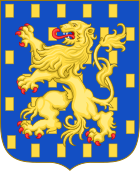
|
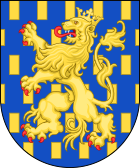
|
| Ottonian (Younger) Line | Walramian (Elder) Line |
Arms of branches
| Arms of the Grand Dukes of Luxembourg | ||||
|---|---|---|---|---|

|

|

|

|

|
| Arms of Adolf of Nassau, King of Germany/King of the Romans (1292–1298) | Arms of the Grand Duke of Luxembourg (1890–1898) | Arms of the Grand Duke of Luxembourg (1898–2000) | Arms of the Grand Duke of Luxembourg (2000–present) | Personal Arms of the Grand Duke of Luxembourg (2000–present) |
| Arms of the Princes of Orange | ||||
|---|---|---|---|---|
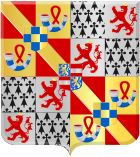
|
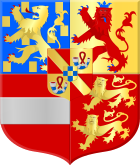
|
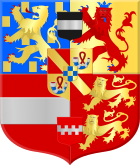
|

|

|
| Arms of René of Chalon and Nassau as Prince of Orange 1530–1544 | Arms of the Prince of Orange 1544–1582, 1584–1618 | Arms of the Prince of Orange 1582–1584, 1625–1702 | Alternate arms of the Prince of Orange | Arms of William III as King of England, Scotland and Ireland, 1688–1702 |
| Arms of the Kings of the Netherlands | |||
|---|---|---|---|

|

|
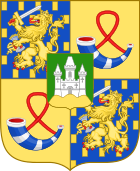
|
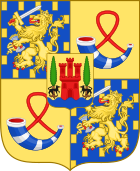
|
| Arms of the King of the Netherlands 1815–1907 | Arms of the Queens and King of the Netherlands 1907–present | Arms of the Prince of Orange/Crown Prince of the Netherlands, 1980–2013 | Arms of the Princess of Orange/Crown Princess of the Netherlands, 2013–present |
Counts of Nassau
| Arms | Name and blazon |
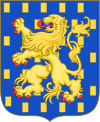
|
Dudo ( † 1117), Count of Laurenbourg approx. 1093 to 1117.
or
|
Walramian line
Comtes de Nassau-Wiesbaden-Idstein
| Achievement | Arms | Name and blazon |
 |

|
Walram II, Count of Nassau, Co-count of Nassau from 1249 to 1255, count of Nassau-Wiesbaden, count of Nassau-Idstein from 1255 to 1276,
or |

|
Adolf, King of the Romans (v. 1255- 2 July 1298), king of Germany (formally king of the Romans) from 1292 to 1298, count of Nassau-Wiesbaden, count of Nassau-Weilburg, count of Nassau-Idstein from 1276 to 1298.
or |
Counts of Nassau-Weilburg
Branches of Nassau-Weilburg
| Achievement | Arms | Name and blazon |

|
John I of Nassau-Weilburg, co-count of Nassau-Weilburg (1355–1371), count of Nassau-Weilburg (1309 à 1371),
| |

|
Philip I of Nassau-Weilburg, Co-count of Nassau, count of Nassau-Wiesbaden, count of Nassau-Idstein, count of Nassau-Saarbrücken, count of Nassau-Neuweilnau,
Arms also borne by:
| |

|

|
William Louis, Count of Nassau-Saarbrücken (1590- 1640), count of Nassau-Saarbrücken, count of Nassau-Ottweiler 1629 to 1640,
|
Branche cadette de Nassau-Weilburg
| Achievement | Arms | Name and blazon |

|
John Ernst, Count of Nassau-Weilburg, count 1675 to 1719,
|
Princes of Nassau-Weilburg
In 1816, the princes of Nassau-Weilburg had inherited all the other Walramian Nassau territories by the family compact and by the Congress of Vienna became dukes of Nassau.
Dukes of Nassau
| Achievement | Arms | Name and blazon |

|

|
William, Duke of Nassau, (1792–1839) duke of Nassau 1816 à 1839,
|
House of Nassau-Weilburg, Grand Dukes of Luxembourg
| Achievement | Arms | Name and blazon |

|

|
Adolphe I of Luxembourg, duke of Nassau 1839 à 1866, grand-duke of Luxembourg (1890–1905),
Arms at his accession (1890)
Les armoiries prises en 1898:
Lesser Arms
Middle Arms
Greater Arms
|
House of Nassau-Weilburg, princes of Bourbon-Parma
| Achievement | Arms | Name and blazon |

|
Jean, Grand Duke of Luxembourg, grand-duke of Luxembourg (1964–2000), son of Charlotte, Grand Duchess of Luxembourg and Prince Felix of Bourbon-Parma,
| |

|
Henri, Grand Duke of Luxembourg, (1955) grand-duke of Luxembourg (2000),son of preceding,
| |
 |
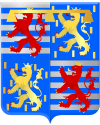
|
Guillaume, Hereditary Grand Duke of Luxembourg, (1981) crown prince (2000), eldest child of the preceding,
Coat of arms granted 2012:
|
Ottonian Line
| Achievement | Arms | Name and blazon |
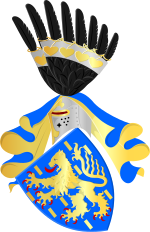
|
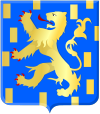
|
Otho I of Nassau (1247 † 1290), co-count of Nassau, count of Nassau-Siegen, count of Nassau-Dillenbourg, count of Nassau-Beilstein, count of Nassau-Ginsberg,
D'azur semé de billettes d'or, au lion du même, armé et lampassé de gueules, brochant sur le tout. or Azure billetty Or, a lion rampant of the last armed and langued gules. |

|
Otto II of Nassau-Siegen (c. 1305 † 1350/1351), comte de Nassau, de Nassau-Dillenbourg et de Nassau-Siegen,
Quarterly, I Azure billetty a lion rampant Or (for Nassau); II Or a lion rampant guardant Gules crowned Azure (Katzenelnbogen); III Gules a fess Argent (Vianden), IV Gules two lions passant guardant Or, armed and langued azure (Dietz).
| |

|
Henry I, Count of Nassau-Beilstein, count of Nassau-Beilstein (Count of Nassau in Beilstein). In 1343, Nassau-Beilstein was split off from Nassau-Dillenburg. In 1561 the possessions of the house of Nassau-Beilstein were inherited by the house of Nassau-Dillenburg.
Quarterly, I Azure billetty a lion rampant Or (for Nassau); II Or a lion rampant guardant Gules crowned Azure (Katzenelnbogen); III Gules a fess Argent (Vianden), IV Gules two lions passant guardant Or, armed and langued azure (Dietz). |
Counts of Nassau-Dillenburg
Henry III of Nassau-Breda came to the Netherlands in 1499 as heir to his uncle, Engelbrecht II of Nassau-Breda. His and his uncle's arms are shown below. When Philbert, prince of Orange died in 1530, his sister's son René of Breda inherited the Princedom of Orange on condition that he used the name and coat of arms of the Châlon-Orange family. History knows him therefore as René of Châlon instead of as "René of Nassau-Breda." The 1st and 4th grand quarters show the arms of the Chalons-Arlay (the gold bend) princes of Orange (the bugle). The blue and gold cross is the arms of Jeanne of Geneva, who married one of the Chalons princes. The 2nd and 3rd show the quarterings of Brittany and Luxembourg-St. Pol. The inescutcheon overall is his paternal arms quartered of Nassau and Breda. William the Silent's father, William the Rich, was rich only in children. He bore the arms shown below. Clockwise from upper left they displayed the arms of Nassau (1st quarter), Katzenelenbogen (3rd quarter), Dietz (2nd quarter), Vianden (4th quarter).
| Achievement | Arms | Name and blazon |

|

|
Engelbert II of Nassau (1451–1504), Count of Nassau-Dillenbourg and Vianden, and lord of Breda, Lek, Diest, Roosendaal, Nispen and Wouw. He was for some time leader of the Privy council of the Duchy of Burgundy. In 1501, Maximilian named him Lieutenant-General of the Low Countries. From that point forward (until his death in 1504) Engelbert was the principal representative of the Habsburg Empire to the region.
Quarterly, I and IV Azure billetty a lion rampant Or (Nassau); II and III Gules a fess Argent (Vianden) |
 
|
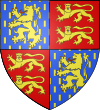 
|
John V, Count of Nassau-Siegen,
Quarterly: I and IV azure sown with billets of gold, the lion of the same, armed and langued Gules, debruising over all (Nassau ); II and III gules two armed leopards of gold, langued and crowned Azure (Dietz ). After 1504: quarterly: I and IV of azure sown with billets of gold, to the lion of the same, armed and langued Gules, debruising on the whole (Nassau ); II and III Gules two leopards Or armed, langued and crowned Azure (Dietz), sur-le-tout Gules a fess Argent (Vianden ). |

|
Henry III of Nassau-Breda, count of Nassau, lord of Breda, de Lek and Diest,
Quarterly, I and IV Azure billetty a lion rampant Or (Nassau); II and III Gules a fess Argent (Vianden). | |

|

|
William of Nassau the Rich or the Old (1487 † 1559), Count of Nassau-Siegen,
Quarterly, I Azure billetty a lion rampant Or (for Nassau); II Or a lion rampant guardant Gules crowned Azure (Katzenelnbogen); III Gules a fess Argent (Vianden), IV Gules two lions passant guardant Or, armed and langued azure (Dietz). |
Illegitimate Lines of the House of Nassau-Breda & Dillenburg
The House of Nassau-Corroy is a bastard branch of the House of Nassau. Unlike the main branch of the House of Nassau, this illegitimate branch was faithful to the king of Spain and Roman Catholic.
| Achievement | Arms | Name and blazon |

|
Alexis van Nassau-Corroy, illeg. son of Henry III of Nassau-Breda, lord of Corroy (descendants made Count of Corroy, 1693) Count of Zwevegem, Baron of Warcoing, Lord of Frasnes-lez-Gosselies,
Quarterly, I and IV Azure billetty a lion rampant Or (Nassau); II and III Gules a fess Argent (Vianden). |
The Great Princes of Orange, House of Orange-Nassau
As the kingdom of Burgundy fragmented in the early Middle Ages, the Holy Roman Emperor Frederick I Barbarossa elevated the lordship of Orange to a principality in 1163 to shore up his supporters in Burgundy against the Pope and the King of France. As the Empire's boundaries retreated from those of the principality, the prince acceded to the sovereign rights that the Emperor formerly exercised. As William the Silent wrote in his marriage proposal to the uncle of his second wife, the Elector August of Saxony, he held Orange as "my own free property", not as a fief of any suzerain; neither the Pope, nor the Kings of Spain or France.
On becoming prince of Orange, William placed the Châlon-Arlay arms in the center ("as an inescutcheon") of his father's arms. He used these arms until 1582 when he purchased the marquisate of Veere and Vlissingen. It had been the property of Philip II since 1567, but had fallen into arrears to the province. In 1580 the Court of Holland ordered it sold. William bought it as it gave him two more votes in the States of Zeeland. He owned the government of the two towns, and so could appoint their magistrates. He already had one as First Noble for Philip William, who had inherited Maartensdijk. This made William the predominant member of the States of Zeeland. It was a smaller version of the countship of Zeeland (& Holland) promised to William, and was a potent political base for his descendants. William then added the shield of Veere and Buren to his arms as shown in the arms of Frederick Henry, William II and William III with the arms of the marquisate in the top center, and the arms of the county of Buren in the bottom center. William also started the tradition of keeping the number of billets in the upper left quarter for Nassau at 17 to symbolize the original 17 provinces of the Burgundian/Habsburg Netherlands, which he always hoped would form one united nation.
As sovereign Princes, the princes of Orange used an independent prince's crown or the princely hat. Sometimes, only the coronet part was used (see, here and here). After the establishment of the Kingdom of the Netherlands, and as the principality of Orange had been incorporated into France by Louis XIV, they used the Dutch Royal Crowns. The full coats of arms of the princes of Orange, later Kings of the Netherlands, incorporated the arms above, the crown, 2 lions as supporters and the motto "Je maintiendrai" ("I will maintain"), the latter taken from the Chalons princes of Orange, who used "Je maintiendrai Chalons".
| Achievement | Arms | Name and blazon |

|

|
René de Nassau, assumed surname of Châlon, Prince of Orange and Stadtholder of Holland, Zeeland, Utrecht and Gelderland
|

|

Puis, |
William I of Orange-Nassau called "the Silent" or in French Le Taciturne or Le Silencieux or Le Jeune (1544–1584), Prince of Orange (1544–1584), stadholder of Holland, Zeeland and Utrecht (1559–1567) and (1572–1584)
Arms 1544–1582:Quarterly, I Azure billetty a lion rampant Or (for Nassau); II Or a lion rampant guardant Gules crowned Azure (Katzenelnbogen); III Gules a fess Argent (Vianden), IV Gules two lions passant guardant Or, armed and langued azure (Dietz); at the fess point an inescutcheon, quarterly I and IV Gules, a bend Or (Châlons); II and III Or a bugle hunting horn Azure, stringed Gules (Orange) with an inescutcheon, Nine pieces Or and Azure (Geneva). The motto: Je Maintiendrai (medieval French for "I will maintain"). The motto represents the House of Orange-Nassau, since it came into the family with the Principality of Orange.
Arms after 1582: Quarterly, I Azure billetty a lion rampant Or (for Nassau); II Or a lion rampant guardant Gules crowned Azure (Katzenelnbogen); III Gules a fess Argent (Vianden), IV Gules two lions passant guardant Or, armed and langued azure (Dietz); between the I and II quarters an inescutcheon, Sable a fess argent (Flushing); at the fess point an inescutcheon, quarterly I and IV Gules, a bend Or (Châlons); II and III Or a bugle hunting horn Azure, stringed Gules (Orange) with an inescutcheon, Nine pieces Or and Azure (Geneva); between the III and IV quarters, an inescutcheon, Gules a fess counter embattled Argent (Buren). The motto: Je Maintiendrai (medieval French for "I will maintain"). The motto represents the House of Orange-Nassau, since it came into the family with the Principality of Orange.
The title Prince of Orange after this became practically synonymous with the stadholder of the most important provinces of the Republic and so its leading personage. |

|
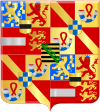
|
Maurice of Nassau, half brother of Philip William of Orange, stadholder of Holland and Zeeland, etc. (1585–1625), prince of Orange (1618–1625).
Quarterly: arms of Saxony (the arms of his mother)sur-le-tout on a shield grand quarterly: I & IV: Quarterly, I Azure billetty a lion rampant Or (for Nassau); II Or a lion rampant guardant Gules crowned Azure (Katzenelnbogen); III Gules a fess Argent (Vianden), IV Gules two lions passant guardant Or, armed and langued azure (Dietz); sur-le-tout Or a fess Sable (Moers) in grand quarters II and III; I and IV Gules, a bend Or (Châlons); II and III Or a bugle hunting horn Azure, stringed Gules (Orange) with an inescutcheon, Nine pieces Or and Azure (Geneva); |
| Fredrick Henry, half brother of Maurice, Prince of Orange, Prince of Orange (1625–1647
Alternative version as seen in contemporary images: Quarterly, I Azure billetty a lion rampant Or (for Nassau); II Or a lion rampant guardant Gules crowned Azure (Katzenelnbogen); III Gules a fess Argent (Vianden), IV Gules two lions passant guardant Or, armed and langued azure (Dietz); between the I and II quarters an inescutcheon, Or a fess Sable (Moers); at the fess point an inescutcheon, quarterly I and IV Gules, a bend Or (Châlons); II and III Or a bugle hunting horn Azure, stringed Gules (Orange) with an inescutcheon, Nine pieces Or and Azure (Geneva); between the III and IV quarters, an inescutcheon, Gules a fess counter embattled Argent (Buren). The motto: Je Maintiendrai (medieval French for "I will maintain"). The motto represents the House of Orange-Nassau, since it came into the family with the Principality of Orange
Here are the armories of William II and III as sovereign princes of Orange and knights of the Garter. | ||
 Armoiries de Frederick Henry comme un chevalier de la Jarretière |
 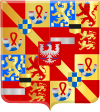
|
Fredrick Henry, personal arms before 1625
Quarterly: sur-le-tout the arms of Coligny Gules an eagle displayed argent beaked langued membered armed and crowned azure (the arms of his mother, daughter of Gaspard II, amiral de France) on a shield grand quarterly: I & IV: Quarterly, I Azure billetty a lion rampant Or (for Nassau); II Or a lion rampant guardant Gules crowned Azure (Katzenelnbogen); III Gules a fess Argent (Vianden), IV Gules two lions passant guardant Or, armed and langued azure (Dietz); sur-le-tout Or a fess Sable (Moers) in grand quarters II and III; I and IV Gules, a bend Or (Châlons); II and III Or a bugle hunting horn Azure, stringed Gules (Orange) with an inescutcheon, Nine pieces Or and Azure (Geneva). |

|

|
William II, personal arms before 1648 as count of Buren
Ecartelé: sur-le-tout the arms of (Buren) Gules a fess counter embattled Argent (Buren) on a shield grand quarterly: I & IV: Quarterly, I Azure billetty a lion rampant Or (for Nassau); II Or a lion rampant guardant Gules crowned Azure (Katzenelnbogen); III Gules a fess Argent (Vianden), IV Gules two lions passant guardant Or, armed and langued azure (Dietz); sur-le-tout Or a fess Sable (Moers) in grand quarters II and III; I and IV Gules, a bend Or (Châlons); II and III Or a bugle hunting horn Azure, stringed Gules (Orange) with an inescutcheon, Nine pieces Or and Azure (Geneva). |

|
Mary of England, princess of Orange, 1677–1689, arms on the expeditionary banner of William III of Orange and Mary of England, 1688
Per pale: 1. as Prince of Orange, William's coat of arms was: Quarterly, I Azure billetty a lion rampant Or (for Nassau); II Or a lion rampant guardant Gules crowned Azure (Katzenelnbogen); III Gules a fess Argent (Vianden), IV Gules two lions passant guardant Or, armed and langued azure (Dietz); between the I and II quarters an inescutcheon, Or a fess Sable (Moers); at the fess point an inescutcheon, quarterly I and IV Gules, a bend Or (Châlons); II and III Or a bugle horn Azure, stringed Gules (Orange) with an inescutcheon, Nine pieces Or and Azure (Geneva); between the III and IV quarters, an inescutcheon, Gules a fess counter embattled Argent (Buren). 2. Mary's arms as princess of England were: Quarterly, I and IV Grand quarterly, Azure three fleurs-de-lis Or (for France) and Gules three lions passant guardant in pale Or (for England); II Or a lion rampant within a double tressure flory-counter-flory Gules (for Scotland); III Azure a harp Or stringed Argent (for Ireland); overall a label argent. |
Illegitimate Lines of Orange-Nassau
| Armoiries | Arms | Name and blazon |

|
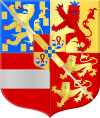
|
Justinus of Nassau, illegitimate son of William the Silent, Admiral & General, Governor of Breda
Quarterly, I Azure billetty a lion rampant Or (for Nassau); II Or a lion rampant guardant Gules crowned Azure (Katzenelnbogen); III Gules a fess Argent (Vianden), IV Gules two lions passant guardant Or, armed and langued azure (Dietz); a bend argent; at the fess point an inescutcheon, quarterly I and IV Gules, a bend Or (Châlons); II and III Or a bugle horn Azure, stringed Gules (Orange) with an inescutcheon, Nine pieces Or and Azure (Geneva). |
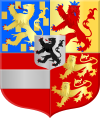
|
Louis of Nassau, lord of den Lek and Beverweerd, Premier Noble of the Province of Holland, illegitimate son of Maurice, Prince of Orange,
Quarterly, I Azure billetty a lion rampant Or (for Nassau); II Or a lion rampant guardant Gules crowned Azure (Katzenelnbogen); III Gules a fess Argent (Vianden), IV Gules two lions passant guardant Or, armed and langued azure (Dietz); at the fess point an inescutcheon, argent a lion rampant sable, armed and langued gules (den Lek)
| |

|

|
Frederick of Nassau, lord of Zuylestein an illegitimate son of Frederick Henry, Prince of Orange,
Quarterly, I Azure billetty a lion rampant Or (for Nassau); II Or a lion rampant guardant Gules crowned Azure (Katzenelnbogen); III Gules a fess Argent (Vianden), IV Gules two lions passant guardant Or, armed and langued azure (Dietz); at the fess point an inescutcheon, gueules three pillars argent 2 and 1, a label of the second overall,. |

|

|
Henry de Nassau d'Auverquerque, 1st Earl of Grantham, son of Henry de Nassau, Lord Overkirk, Earl of Grantham in England
Quarterly, I Azure billetty a lion rampant Or (for Nassau); II Or a lion rampant guardant Gules crowned Azure (Katzenelnbogen); III Gules a fess Argent (Vianden), IV Gules two lions passant guardant Or, armed and langued azure (Dietz); at the fess point an inescutcheon, argent a lion rampant sable, armed and langued gules (den Lek) |

|

|
William de Nassau-Zuylestein, Earl of Rochford, secretary of state for the Northern Department, descendant of Frederick of Nassau, lord of Zuylestein an illegitimate son of Frederick Henry, Prince of Orange,
Quarterly, I Azure billetty a lion rampant Or (for Nassau); II Or a lion rampant guardant Gules crowned Azure (Katzenelnbogen); III Gules a fess Argent (Vianden), IV Gules two lions passant guardant Or, armed and langued azure (Dietz); at the fess point an inescutcheon, gueules three pillars argent 2 and 1, a label of the second overall. |
King of England, Scotland, and Ireland
| Achievement | Arms | Name and blazon |
 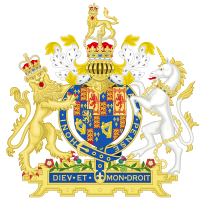 
|
Plus, Plus, |
William III of Orange and Nassau, Prince of Orange, Count of Nassau baron of Breda, and Stadtholder of Holland and Zeeland, Stadtholder of Utrecht, Stadtholder of Gelderland and Overijssel, plus King of England, Scotland, and Ireland,
Arms as Prince of Orange, as above. As prince of England, Scotland, and Ireland (in right of his mother Mary, Princess Royal and Princess of Orange (Princess Royal)). As King and Queen of England, Scotland and Ireland, Cojoint with his wife and cousin Mary II: Per pale: 1. Quarterly, I and IV Grand quarterly, Azure three fleurs-de-lis Or (for France) and Gules three lions passant guardant in pale Or (for England); II Or a lion rampant within a double tressure flory-counter-flory Gules (for Scotland); III Azure a harp Or stringed Argent (for Ireland); overall an escutcheon Azure billetty a lion rampant Or., 2. Quarterly, I and IV Grand quarterly, Azure three fleurs-de-lis Or (for France) and Gules three lions passant guardant in pale Or (for England); II Or a lion rampant within a double tressure flory-counter-flory Gules (for Scotland); III Azure a harp Or stringed Argent (for Ireland). As King of England, Scotland, and Ireland, Quarterly, I and IV Grand quarterly, Azure three fleurs-de-lis Or (for France) and Gules three lions passant guardant in pale Or (for England); II Or a lion rampant within a double tressure flory-counter-flory Gules (for Scotland); III Azure a harp Or stringed Argent (for Ireland); overall an escutcheon Azure billetty a lion rampant Or. In his later coat of arms, William used the motto: Je Maintiendrai (medieval French for "I will maintain"). The motto represents the House of Orange-Nassau, since it came into the family with the Principality of Orange. |
Princes of Nassau-Dillenbourg and princes of Nassau-Siegen
In 1739 the House of Orange-Nassau inherited the possessions of the Nassau-Dillenbourg line.
| Achievement | Arms | Name and blazon |

after 1654: with crests: |

|
Johann VI, Count of Nassau-Dillenburg, count of Nassau-Dillenbourg (Count of Nassau in Dillenburg), Nassau-Siegen, Nassau-Hadamar et de Nassau-Dietz, Stadholder of Friesland, Gelderland and Zutphen,
Quarterly, I Azure billetty a lion rampant Or (for Nassau); II Or a lion rampant guardant Gules crowned Azure (Katzenelnbogen); III Gules a fess Argent (Vianden), IV Gules two lions passant guardant Or, armed and langued azure (Dietz). While already being princely counts, directly represented in the imperial diet and subject only to the Emperor, after 1654 Holy Roman Emperor Ferdinand III raised the whole House of Nassau to the rank of Princes of the Holy Roman Empire (Reichsfürst).
|
Counts of Nassau-Siegen, protestant branch
| Achievement | Arms | Name and blazon |

apres 1654: |
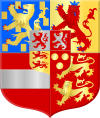
|
Henry of Nassau-Siegen,count and prince of Nassau-Siegen, brother of John Maurice, Prince of Nassau-Siegen, surnamed "the Brazilian"
Quarterly, I Azure billetty a lion rampant Or (for Nassau); II Or a lion rampant guardant Gules crowned Azure (Katzenelnbogen); III Gules a fess Argent (Vianden), IV Gules two lions passant guardant Or, armed and langued azure (Dietz); overall an inescutcheon on the fess point, 1, argent a lion rampant gueules (Limburg), 2, gueules a lion rampant argent armed and langued of the first (Bronckhorst), 3, or two lions passant gueules (Wisch), 4, gueules three bezants or (Borculo) (from the marriage in 1646 of Henri de Nassau-Siegen and Maria Magdalena of Limburg-Stirum for the lordship of Wisch, which entered the protestant line of the counts of Nassau-Siegen). Arms of House of Limburg-Stirum: |
Nassau-Dietz
In 1606 the Nassau-Dillenburg branch partitioned also into Nassau-Dietz and Nassau-Siegen.
| Achievement | Arms | Name and blazon |

apres 1654: |

Puis, |
Ernest Casimir I, Count of Nassau-Dietz, count of Nassau-Dietz, stadtholder of Friesland, Drenthe and Groningen,
Quarterly, I Azure billetty a lion rampant Or (for Nassau); II Or a lion rampant guardant Gules crowned Azure (Katzenelnbogen); III Gules a fess Argent (Vianden), IV Gules two lions passant guardant Or, armed and langued azure (Dietz) V, argent a stag passant gueules the crest of the stag passant (Spiegelberg); VI, argent a fess sable on top of in the chief two tufts or sheaves vert (Liesveld); overall an inescutcheon in the fess point argent a cross sable (cross of the Teutonic Order).
|
Princes of Orange-Nassau(-Dietz)
In 1702, the line of Nassau-Dietz inherited the principality of Orange according to the will of William III, and became the line of Orange-Nassau-Dietz. However, France disputed this and occupied the principality.
When John William Friso became Prince of Orange, he used the arms below. However, he was never recognized outside of Holland and areas friendly to Holland as Prince of Orange. His son, William IV, recognized as Prince of Orange, seems to have used the original arms of William the Silent. When the princes of Orange fled the Netherlands during the Batavian Republic and the Kingdom of Holland, and when France occupied the Netherlands, they were compensated by Napoleon with the Principality of Nassau-Orange-Fulda. These principalities were confiscated when Napoleon invaded Germany (1806) and William VI supported his Prussian relatives. He succeeded his father as Prince of Orange later that year, after William V's death. The house of Orange-Nassau also had several illegitimate lines (see below) who based their arms on the arms of Nassau-Dillenburg.
In 1814, the Congress of Vienna reached a concord that awarded the whole county of Nassau, raised to a duchy, to the Walramian branch (Nassau-Weilburg). In compensation, the Ottonian Branch (princes of Orange), and then raised to King of the Netherlands, were awarded the Grand Duchy of Luxemburg as their personal dominion. So, when Belgium became independent, Luxemburg remained with the house of Orange-Nassau in personal union with the Dutch monarch. In 1890, with the death of William III of the Netherlands, Luxemburg was inherited by the Walramian branch as part of this compact.
| Achievement | Arms | Name and blazon |

|

|
John William Friso, Prince of Orange, prince of Nassau-Dietz, stadthouder of Friesland and Groningen, prince of Orange,
Quarterly, I Azure billetty a lion rampant Or (for Nassau); II Or a lion rampant guardant Gules crowned Azure (Katzenelnbogen); III Gules a fess Argent (Vianden), IV Gules two lions passant guardant Or, armed and langued azure (Dietz) V, argent a stag passant gueules the crest of the stag passant (Spiegelberg); VI, argent a fess sable on top of in the chief two tufts or sheaves vert (Liesveld); at the fess point an inescutcheon, quarterly I and IV Gules, a bend Or (Châlons); II and III Or a bugle horn Azure, stringed Gules (Orange) with an inescutcheon, Nine pieces Or and Azure (Geneva); at the honor point between the I and II quarters an inescutcheon, Or a fess Sable (Moers); at the nombril point between the V and VI quarters, an inescutcheon, Gules a fess counter embattled Argent (Buren).;;
|
| William IV, Prince of Orange, prince of Nassau-Dietz, prince of Orange-Nassau, Stadtholder of Friesland, then Stadtholder of Holland and Zeeland, Stadtholder of Utrecht, Stadtholder of Gelderland and Overijssel 1747 à 1751,
Quarterly, I Azure billetty a lion rampant Or (for Nassau); II Or a lion rampant guardant Gules crowned Azure (Katzenelnbogen); III Gules a fess Argent (Vianden), IV Gules two lions passant guardant Or, armed and langued azure (Dietz); at the fess point an inescutcheon, quarterly I and IV Gules, a bend Or (Châlons); II and III Or a bugle horn Azure, stringed Gules (Orange) with an inescutcheon, Nine pieces Or and Azure (Geneva). The motto: Je Maintiendrai (medieval French for "I will maintain"). The motto represents the House of Orange-Nassau, since it came into the family with the Principality of Orange.
| ||

|
Puis, |
William VI of Orange-Nassau, prince of Nassau-Dietz, prince of Orange-Nassau, after 1815 King of the Netherlands.
the arms as Prince of Nassau-Orange-Fulda (1803–1813),
Then 1813 to 1815, as Sovereign Prince of the United Netherlands
|
Counts and Princes of Nassau-Schaumburg
| Achievement | Arms | Name and blazon |

|

|
Adolph, Prince of Nassau-Schaumburg,count and prince of Nassau in Schaumburg, (1629 – 1676) son of Louis Henry, Prince of Nassau-Dillenburg
Quarterly, I Azure billetty a lion rampant Or (for Nassau); II Or a lion rampant guardant Gules crowned Azure (Katzenelnbogen); III Gules a fess Argent (Vianden), IV Gules two lions passant guardant Or, armed and langued azure (Dietz); overall an inescutcheon on the fess point, 1 and 4, gules a lion rampant or holding in right a spear or, 2 and 3, argent a griffin gules rampant in the right a nut or; in the center of that in the fess point, azure an apple tree with fruit or all under a coronet, or. |
Kings of the Netherlands (House of Orange-Nassau)
When William VI of Orange returned to the Netherlands in 1813 and was proclaimed Sovereign Prince of the Netherlands, he quartered the former Arms of the Dutch Republic (1st and 4th quarter) with the "Châlon-Orange" arms (2nd and 3rd quarter), which had come to symbolize Orange (see above). As an in escutcheon he placed his ancestral arms of Nassau. When he became King in 1815, he combined the Dutch Republic Lion with the billets of the Nassau arms and added a royal crown to form the Coat of arms of the Netherlands. In 1907, Queen Wilhelmina replaced the royal crown on the lion and the shield bearers of the arms with a coronet.
Wilhelmina further decreed that in perpetuity her descendants should be styled "princes and princesses of Orange-Nassau" and that the name of the house would be "Orange-Nassau" (in Dutch "Oranje-Nassau"). Only those members of the members of the Dutch Royal Family that are designated to the smaller "Royal House" can use the title of prince or princess of the Netherlands (according to the Membership to the Royal House Act which was revised in 2002.) Since then, individual members of the House of Orange-Nassau are also given their own arms by the reigning monarch, similar to the United Kingdom. This is usually the royal arms, quartered with the arms of the principality of Orange, and an in escutcheon of their paternal arms.
The Royal House of the Netherlands tends to use Heraldic flags more extensively than their arms. So these are also shown here.
| Achievement | Arms | Heraldic Flag | Name and blazon |
 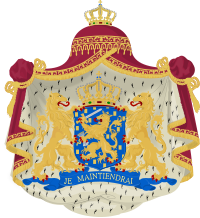 
|
 After 1907:  |
 (1908–2013)  (2013 – ) 
|
William I of the Netherlands (1772–1843), prince of Orange, King of the Netherlands, duke and grand duke of Luxembourg (until 1890, when Luxembourg went by treaty and family compact to Duke Adolph of Nassau), & etc.
Coat of arms of the Netherlands:
In 1907, Queen Wilhelmina simplfied the arms: the lion was now represented with an open crown. The two lion supporters were represented rampant and without a crown.
|
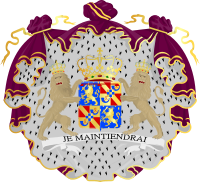
|
 
|

|
Crown Prince of the Netherlands (prince of Orange) in the XIX century
his eldest son the hereditary prince of the Netherlands:
|
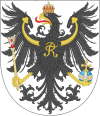 |
Wilhelmine of Prussia, Queen of the Netherlands (1774–1837), queen consort of King William I of the Netherlands, daughter of King Frederick William II of Prussia.
| ||
 |

|
Prince Frederick of the Netherlands (1797–1881), son of King William I of the Netherlands | |

|
Louise of the Netherlands (1828† 1871), princess of the Netherlands, Queen consort of Sweden and Norway (8 July 1859 – 18 September 1872), daughter of Prince Frederick of the Netherlands
| ||

|
Princess Marie of the Netherlands (1841 + 1910) married William, Prince of Wied and mother of Wied, Prince of Albania, King of Albania. Daughter of Prince Frederick of the Netherlands. | ||
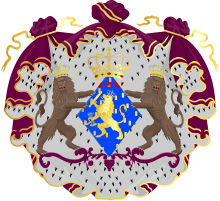 |
 |

|
Princess Marianne of the Netherlands (1810–1883), daughter of King William I of the Netherlands, married her first cousin Prince Albert, the fourth son of her mother's brother, King Frederick William III of Prussia. The union produced five children
|
 |
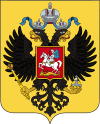 |
Anna Pavlovna of Russia (1795–1865), queen consort of King William II of the Netherlands, daughter of Emperor Paul I of Russia.
| |
 |

|
Sophie of Württemberg (1818–1877), Queen Consort of the Netherlands, wife of King William III of the Netherlands
| |
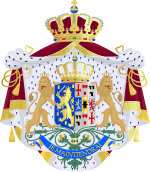 |
 |

|
Emma of Waldeck and Pyrmont (1854–1934), Queen Consort of the Netherlands, Regent of the Netherlands (1890–1898)
* |
 |
 |

|
Duke Henry of Mecklenburg-Schwerin (1876–1934), prince consort of the Netherlands
|
House of Orange-Nassau, princess of Mecklenburg-Schwerin
| Achievement | Arms | Heraldic Flag | Name and blazon |

|
  |
as a princess: 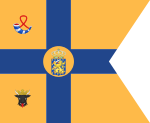
|
Juliana of the Netherlands, Queen of the Netherlands (1948–1980), princess of Orange-Nassau, duchess of Mecklemburg-Schwerin, countess of Nassau.
as Crown Princess and Princess of Orange;
as Queen (1948–1980):
after her abdication (1980–2004), she used her arms like a princess above. |
 |
 |

|
Prince Bernhard of the Netherlands (1911–2004), prince of Lippe -Beisterfeld, prince consort of the Netherlands 1948 – 1980
|
House of Orange-Nassau, princess of Lippe-Biesterfeld
| Achievement | Arms | Heraldic Flag | Name and blazon |
 |
 
|

|
Beatrix of the Netherlands, Queen of the Netherlands (1980–2013), princesse of Orange-Nassau, princess of Lippe-Biesterfeld
Crown Princess/Princess of Orange:
As Queen (1980–2013):
after her abdication (2013), she used her arms like a princess. |
 |
 |

|
Claus von Amsberg (1926–2002) Jonkheer van Amsberg, prince consort of the Netherlands, prince of the Netherlands
|
 |
 |

|
Princesses Irene, Margriet et Christina, princesses of Orange-Nassau, princesses of Lippe-Biesterfeld.
Princesses Irene and Christina converted to Catholicism on their marriage. They thus lost their place in the royal house as princesses of the Netherlands, and their children are not considered members of the house of Orange-Nassau. |
 |
 |

|
Prince Maurits of Orange-Nassau, van Vollenhoven, Prince Bernhard of Orange-Nassau, van Vollenhoven, Prince Pieter-Christiaan of Orange-Nassau, van Vollenhoven, and Prince Floris of Orange-Nassau, van Vollenhoven, princes of Orange-Nassau, princes of Lippe-Biesterfeld, sons of princesse Margriet and Pieter van Vollenhoven
|
House of Orange-Nassau, Jonkheere van Amsberg (van Orange-Nassau van Amsberg)
| Achievement | Arms | Heraldic Flag | Name and blazon |
 |
 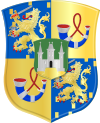
|

|
King William-Alexander of the Netherlands, King of the Netherlands (2013), Prince of Orange-Nassau, Jonkheer van Amsberg
as King of the Netherlands: |
 |
 |
For Maxima as Princess or the Netherlands and her daughters: 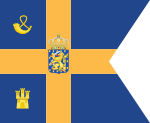
|
Queen Maxima of the Netherlands, Queen consort of the Netherlands (2013), and
Princesses Catherine-Amalia, princesse of Orange, (2003–) Princess Alexia of the Netherlands and Princess Ariane of the Netherlands, princesses of the Netherlands and Orange-Nassau, jonkvrouwe van Amsberg,
|
 |

|

|
House of Orange-Nassau van Amsberg see also House of Amsberg. "Van Orange-Nassau van Amsberg" is the name of the title as count or countess in the Netherlands that the members carry after 2002 that are not also princes of the Netherlands. The other title is Jonkheer(or Jonkvrouw) van Amsberg.
Princes Willem-Alexander, prince of Orange, (1962–2013) Friso and Constantin des Pays-Bas, princes of the Netherlands, princes of Orange-Nassau, Jonkheere van Amsberg,
Arms borne by: the children of Prince Friso of Orange-Nassau:
the children of Prince Constantijn of the Netherlands:
|
 |
 |
Princess Laurentien of the Netherlands (1966– ) wife of Prince Constantijn of the Netherlands
|
Notes and references
- D. Endean Ivall, Cornish Heraldry and Symbolism, 1988. ISBN 1-85022-043-3 (Source: Misc. Rolls of Chanc. Nos 311 and 312.)
- Fox-Davies, Arthur Charles (1909). A COMPLETE GUIDE TO HERALDRY. London, Edinburgh: T. C. & E. C. JACK. p. 22.
- ^ Rietstap, Johannes Baptist (1861). Armorial général, contenant la description des armoiries des familles nobles et patriciennes de l'Europe: précédé d'un dictionnaire des termes du blason. G.B. van Goor. p. 746.
- ^ Rietstap, Johannes Baptist (1861). Armorial général, contenant la description des armoiries des familles nobles et patriciennes de l'Europe: précédé d'un dictionnaire des termes du blason. G.B. van Goor. p. 746.
- "web.genealogie.free.fr". 30 April 2013. Archived from the original on 23 September 2007. Retrieved 21 May 2019.
- ^ La Cour grand-ducale (ed.). "Cour de Grand-Ducale de Luxembourg: Armoiries" (in French). Luxembourg City, Luxembourg. Retrieved 24 April 2019.:
Armoiries valables du Grand-Duc Adolphe au Grand-Duc Jean
Grandes armes Parti de trois coupé de trois, qui font seize quartiers, les quatre quartiers du centre formant écu sur le tout, écartelé de Nassau et de Luxembourg:
au I de Sarrebruck qui est d'azur semé de croisettes recroisettées au pied fiché d'argent, au lion du même couronné d'or, brochant, au II de Merenberg qui est de sinople au sautoir d'or cantonné de douze croisettes du même, au III de Weilnau qui est d'or à deux léopards de gueules, lampassés d'azur, au IV de Moers, qui est d'or à la fasce de sable, au V de Katzenelnbogen qui est d'or au léopard lionné de gueules, armé et lampassé d'azur, au VI de Nassau qui est d'azur semé de billettes d'or, au lion même, armé et lampassé de gueules, couronné d'or brochant (formant premier quartier du surtout), au VII de Luxembourg qui est burelé d'argent et d'azur, au lion de gueules, armé, lampassé et couronné d'or, la queue fourchue et passée en sautoir, brochant (deuxième quartier surtout), au VIII de Saarwerden, qui est de sable à l'aigle éployée d'argent, armée d'or, lampassée de gueules, au IX de Dietz qui est de gueules à deux léopards d'or, armés et lampassés d'azur, l'un sur l'autre, au X de Luxembourg (voir VII), formant le quartier III du surtout, au XI de Nassau (voir VI), formant le quartier IV du surtout, au XII de Lahr qui est d'or à la fasce de gueules, au XIII de Vianden qui est de gueules à la fasce d'argent, au XIV de Kirchberg, qui est d'argent à trois pals de sable, au XV de Sayn, qui est de gueules à léopard lionné d'or, armé et lampassé d'azur, la queue fourchue (et passé en sautoir), au XVI de Mahlberg qui est d'or au lion de sable, armé, lampassé et couronné de gueules. L'écu est surmonté de six casques, le premier et le sixième couronnés.
Cimiers:
Une tête et col de lévrier contourné d'or, lampassé de gueules, colleté de sable, bordé et bouclé d'argent. Lambrequins d'or et de sable (Moers). Un vol coupé d'argent et de sable. L. d'argent et de sable (Sarrebruck). Un lion assis d'or, lampassé et couronné de gueules, entre deux proboscides d'azur semées de billettes d'or (Nassau). Lambrequins d'or et d'azur. Un vol de sable (pour Luxembourg). Lambrequins d'argent et d'azur. Un vol de sable chargé d'un disque de gueules à deux léopards d'or. L. d'or et de gueules (Diez). Un chapeau pyramidal d'or, la pointe recourbée. L. d'or et de gueules (Sayn). Support: deux lions couronnés d'or, lampassés de gueules, la tête contournée.
L'écu et les supports posés sur quatre rinceaux entrelacés d'or.
Manteau de pourpre, frangé et lié d'or, doublé d'hermines, sommé de la couronne royale.
Théoriquement, les trois ordres: Lion d'Or de Nassau, Couronne de Chêne et Ordre d'Adolphe de Nassau devraient être appendus en bas de l'écu, mais cela ne fut jamais réalisé.
Moyennes armes L'écartelé de Nassau-Luxembourg (formant surtout dans les grandes armes), sommé d'une couronne royale, supporté par les deux lions, le tout sous le manteau de pourpre couronné de la couronne royale.
Petites Armes
L'écartelé Nassau-Luxembourg sommé de la couronne royale (sans supports ni manteau).
- La brisure usuelle des Bourbons-Parme est une bordure de gueules chargée de huit coquilles d'argent
- "Other versions of Grand Ducal Arms".
 ,
,  ,
, 
- La Cour grand-ducale (ed.). "Cour de Grand-Ducale de Luxembourg: Armoiries" (in French). Luxembourg City, Luxembourg. Retrieved 24 April 2019.:
Armoiries fixées par S.A.R. le Grand-Duc Henri
Petites armoiries Ecartelé, aux I et IV de Luxembourg qui est un burelé d'argent et d'azur, au lion de gueules, la queue fourchue et passée en sautoir, armé, lampassé et couronné d'or, aux II et III de Nassau qui est d'azur semé de billettes d'or, au lion couronné d'or, armé et lampassé de gueules.
L'écu est timbré d'une couronne royale.
Armoiries moyennes Les petites armoiries augmentées de supports, à dextre un lion couronné d'or, la tête contournée, la queue fourchue et passée en sautoir, armé et lampassé de gueules, à senestre un lion couronné d'or, la tête contournée, armé et lampassé de gueules.
Grandes armoiries Ecartelé, aux I et IV de Luxembourg qui est burelé d'argent et d'azur, au lion de gueules, la queue fourchue et passée en sautoir, armé, lampassé et couronné d'or, aux II et III Nassau qui est d'azur semé de billettes d'or, au lion couronné du même, armé et lampassé de gueules, sur le tout en cœur de Bourbon de Parme qui est d'azur à trois (deux, une) fleurs de lys d'or à la bordure de gueules chargée de huit coquilles d'argent posées en orle.
L'écu est timbré d'une couronne royale et entouré du ruban et de la croix de l'Ordre de la Couronne de Chêne.
Les supports sont à dextre un lion couronné d'or, la tête contournée, la queue fourchue passée en sautoir, armé et lampassé de gueules, à senestre un lion couronné d'or, la tête contournée, armé et lampassé de gueules, chaque lion tenant un drapeau luxembourgeois frangé d'or.
Le tout est posé sur un manteau de pourpre, double d'hermine, bordé, frangé et lié d'or et sommé d'une couronne royale, les drapeaux dépassant le manteau.
- La Cour grand-ducale (ed.). "Cour de Grand-Ducale de Luxembourg: Arrêté grand-ducal du 31 octobre 2012 fixant les petites et les grandes armoiries de Son Altesse Royale le Grand-Duc Héritier" (PDF) (in French) (Mémorial A, number 236, of 9 November 2012 ed.). Luxembourg City, Luxembourg. Retrieved 9 November 2012.
Nous Henri, Grand-Duc de Luxembourg, Duc de Nassau,
Vu la loi modifiée du 23 juin 1972 sur les emblèmes nationaux;
Vu la proposition de la Commission héraldique de l'Etat du 17 juillet 2012;
Arrêtons:
Art. 1er. Les petites armoiries de Son Altesse Royale le Grand-Duc Héritier sont fixées comme suit:
Ecartelé, aux I et IV de Luxembourg qui est un burelé d'argent et d'azur, au lion de gueules, la queue fourchue et passée en sautoir, armé, lampassé et couronné d'or; aux II et III de Nassau qui est d'azur semé de sept billettes d'or, au lion couronné d'or, armé et lampassé de gueules; un lambel à trois pendants d'or brochant en chef. L'écu est timbré d'une couronne royale. Art. 2. Les grandes armoiries de Son Altesse Royale le Grand-Duc Héritier sont fixées comme suit:
Les petites armoiries chargées en cœur d'un écusson aux armes de Bourbon de Parme qui sont d'azur aux trois (deux, une) fleurs de lys d'or à la bordure de gueules chargée de huit coquilles d'argent posées en orle. Les supports sont à dextre un lion couronné d'or, la tête contournée, la queue fourchue et passée en sautoir, armé et lampassé de gueules, à senestre un lion couronné d'or, la tête contournée, armé et lampassé de gueules. Le tout est posé sur un manteau de pourpre, doublé d'hermine, bordé, frangé et lié d'or, et sommé d'une couronne royale. Art. 3. Notre Premier Ministre, Ministre d'Etat est chargé de l'exécution du présent arrêté qui sera publié au Mémorial.
Le Premier Ministre,
Ministre d'Etat,
Jean-Claude Juncker
Château de Berg, le 31 octobre 2012.
Henri
- ^ Rietstap, Johannes Baptist (2003). Armorial general. Vol. 2. Genealogical Publishing Co. p. 297. ISBN 0-8063-4811-9. Retrieved 26 May 2015.:
Arms of Nassau-Dillenburg: Écartelé au 1 d'azur semé de billettes d'or au lion du même armé et lampassé de gueules brochant sur le tout (Nassau) au 2 d'or au léopard lionné de gueules armé lampassé et couronné d'azur (Katzenelnbogen) au 3 de gueules à la fasce d'argent (Vianden) au 4 de gueules à deux léopards d'or armés et lampassés d'azur l'un sur l'autre (Dietz) Cimiers 1° un demi-vol contourné de sable ch d'une barre voûtée d'argent surch de trois feuilles de tilleul d'or posées en bandes les tiges en haut (Nassau) Lambrequin d'or et d'azur 2° un vol de sable chaque aile ch d'une disque aux armes du 2 le léopard lionné de l'aile dextre contourné Lambrequin d'or et de gueules 3° un demi-vol de sable ch d'un disque aux armes du 4 Lambrequin d'or et de gueules
- ^ Pinches, John Harvey; Pinches, Rosemary (1974), The Royal Heraldry of England, Heraldry Today, Slough, Buckinghamshire: Hollen Street Press, pp. 191–192, ISBN 0-900455-25-X
- Rietstap, Johannes Baptist (2003). Armorial general. Vol. 2. Genealogical Publishing Co. p. 297. ISBN 0-8063-4811-9. Retrieved 26 May 2015.:
Arms of Nassau-Dillenburg-Beilstein: Les armes de Nassau-Dillenburg les cimiers remplacés quelquefois par un bonnet princier.
- "Armorial de J.B. RIETSTAP - et ses Compléments". Archived from the original on 9 December 2011. Retrieved 21 May 2019.
- ^ Rietstap, Johannes Baptist (2003). Armorial general. Vol. 2. Genealogical Publishing Co. p. 297. ISBN 0-8063-4811-9. Retrieved 26 May 2015.:
Arms of Nassau-Vianden: Écartelé aux 1 et 4 d'azur semé de billettes d'or au lion du même armé et lampassé de gueules brochant sur le tout (Nassau) aux 2 et 3 de gueules à la fasce d'argent (Vianden) Cimier un demi-vol de sable ch d'une bande voûtée d'argent surch de trois feuilles de tilleul d'or les tiges en haut.
- ^ Wapenboek Nassau-Vianden (in Dutch). Duchy of Brabant, Breda?. 1485–1495.
- Rietstap, Johannes Baptist (2003). Armorial general. Vol. 2. Genealogical Publishing Co. p. 297. ISBN 0-8063-4811-9. Retrieved 26 May 2015.:
Arms of Nassau-Dietz:Écartelé aux 1 et 4 d'azur semé de billettes d'or au lion du même armé et lampassé de gueules brochant sur le tout (Nassau) aux 2 et 3 de gueules à deux léopards d'or armés et lampassés d'azur l'un sur l'autre (Dietz) Cimier un demi-vol de sable ch d'une bande voûtée d'argent surch de trois feuilles de tilleul d'or posées en barres les tiges en haut.
- Rietstap, Johannes Baptist (2003). Armorial general. Vol. 2. Genealogical Publishing Co. p. 297. ISBN 0-8063-4811-9. Retrieved 26 May 2015.:
Arms of Nassau-Vianden-Dietz:Les armes de Nassau Dietz Sur le tout de gueules à la fasce d'argent (Vianden).
- Félix Victor Goethals, Dictionnaire généalogique et héraldique des familles nobles du royaume de Belgique, Volume 4 (Polack-Duvivier, 1852)
- "Biekorf. Jaargang 58 · DBNL".
- Rietstap, Johannes Baptist (2003). Armorial general. Vol. 2. Genealogical Publishing Co. p. 297. ISBN 0-8063-4811-9. Retrieved 26 May 2015.:
Arms of Nassau-Corroy: Écartelé aux 1 et 4 d'azur semé de billettes d'or au lion du même armé et lampassé de gueules brochant sur le tout (Nassau) aux 2 et 3 de gueules à la fasce d'argent (Vianden) Enté en p. d'azur.
- Grew, Marion Ethel (1947). The House of Orange. London: Methuen & Co. Ltd. pp. 2–3.
- Rowen, Herbert H. (1988). The princes of Orange: the stadholders in the Dutch Republic. Cambridge University Press. p. 11. ISBN 0-8063-4811-9.
- William I to Elector August I of Saxony, 16 April 1564 (1835–1915). van Prinsterer, F.Groen; et al. (eds.). Archives ou correspondance inedite de la Maison d'Orange-Nassau. series 1. Vol. 1. Leiden and Utrecht. p. 232.
{{cite book}}: CS1 maint: numeric names: authors list (link) - ^ Rowen, Herbert H. (1988). The princes of Orange: the stadholders in the Dutch Republic (2nd ed.). Baltimore: Cambridge University Press. p. 29. ISBN 978-0-8063-4811-7. LCCN 65021472.:
He used these arms until 1582 when he purchased the marquisate of Veere and Vlissingen. It had been the property of Philip II since 1567, but had fallen into arrears to the province. In 1580 the Court of Holland ordered it sold. William bought it as it gave him two more votes in the States of Zeeland. He owned the government of the two towns, and so could appoint their magistrates. He already had one as First Noble for Philip William, who had inherited Maartensdijk. This made William the predominant member of the States of Zeeland. It was a smaller version of the countship of Zeeland (& Holland) promised to William, and was a potent political base for his descendants. William then added the shield of Veere and Buren to his arms.
- Grew, Marion Ethel (1947). The House of Orange. London: Methuen & Co. Ltd.
- Rietstap, Johannes Baptist (2003). Armorial general. Vol. 2. Genealogical Publishing Co. p. 297. ISBN 0-8063-4811-9. Retrieved 26 May 2015.:
Arms of Rene of Chalons:Ecartelé: I et IV de Châlon-Orange; II et III contre-écartelé d'hermine et d'argent au lion de gueules armé et lampassé d'azur; sur-le-tout écartelé de Nassau et Vianden.
- ^ Rietstap, Johannes Baptist (2003). Armorial general. Vol. 2. Genealogical Publishing Co. p. 297. ISBN 0-8063-4811-9. Retrieved 26 May 2015.:
Arms of William the Silent: Ecartelé: au 1. d'azur, semé de billettes d'or au lion d'or, armé et lampassé de gueules, brochant sur le tout (Maison de Nassau); II, d'or, au léopard lionné de gueules, arméc ouronné et lampassé d'azur (Katzenelnbogen); III, de gueules à la fasce d'argent (Vianden); IV, de gueules à deux lions passant l'un sur l'autre; sur-le-tout écartelé, aux I et IV de gueules, à la bande d'or (Châlon), et aux II et III d'or, au cor de chasse d'azur, virolé et lié de gueules (Orange); sur-le-tout-du-tout de cinq points d'or équipolés à quatre d'azur (Genève); un écusson de sable à la fasce d'argent brochant en chef (Marquis de Flessingue et Veere); un écusson de gueules à la fasce bretessée et contre-bretessée d'argent brochant en pointe (Buren). Trois cq. cour. C.:1. un demi-vol cont., coupé d'or sur gu. (Châlon); 2. une ramure de cerf d'or (Orange); 3. un demi-vol de sa., ch. d'un bisque aux armes de Dietz. Supporters: deus lions d'or, arm. et lampasse de gules. D.: JE MAINTIENDRAI
- "Coat of arms Maurice, Prince of Orange, KG from the Garter Roll of Arms". 3 December 2013. Retrieved 29 November 2016.

- Rietstap, Johannes Baptist (1861). Armorial général, contenant la description des armoiries des familles nobles et patriciennes de l'Europe: précédé d'un dictionnaire des termes du blason. G.B. van Goor. p. 746. :
a la exception de celebre prince Maurice qui portai les armes ... 'Écartelé: les armes de Saxe (celles de sa mere)sur-le-tout dans un ecu ec.: aux I & IV: a. d'azur, semé de billettes, au lion d'or, armé et lampassé de gueules, brochant sur le tout (Nassau); b. d'or, au léopard lionné de gueules, arméc ouronné et lampassé d'azur (Katzenelnbogen); c. de gueules à la fasce d'argent (Vianden); d. de gueules à deux lions passant l'un sur l'autre; sur-le-tout d'or au chev. de sable (Moers) aux II. et III. c.-ec. a. aux I et IV de gueules, à la bande d'or (Châlons), et d. aux II et III d'or, au cor de chasse d'azur, virolé et lié de gueules (Orange); sur-le-tout-du-tout de cinq points d'or équipolés à quatre d'azur (Genève)
- Haley, K(enneth) H(arold) D(obson) (1972). The Dutch in the Seventeenth Century (1st ed.). Thames and Hudson. p. 78. ISBN 978-0-15-518473-2. LCCN 72157880.
- Anonymous. "Wapenbord van Prins Maurits met het devies van de Engelse orde van de Kouseband". Exhibit of a painted woodcut of Maurice's Arms encircled by the Order of the Garter in the Rijksmuseum, Amsterdam. Rijksmuseum, Amsterdam. Archived from the original on 11 January 2012. Retrieved 26 April 2011.
- see Frederick Henry, Prince of Orange, death procession
- "Coat of arms William II, Prince of Orange, KG from the Garter Roll of Arms". 13 December 2013. Retrieved 29 November 2016.

- https://commons.wikimedia.org/File:Histoire-de-Guillaume-III-MG_0122.tif , , . Expeditionary Banner for 1688 21 March 2019
- "INTERIEUR, OVERZICHT GRAFMONUMENT IN HET KOOR – Ouderkerk aan den IJssel". Wikimedia. WikiFoundation. 1 July 1994. Retrieved 2 December 2016.
Du tombeau monumental des comtes de Nassau-La Lecq l'église en Ouderkerk an den IJssel, Pays-Bas
- Rietstap, Johannes Baptist (2003). Armorial general. Vol. 2. Genealogical Publishing Co. p. 297. ISBN 0-8063-4811-9. Retrieved 26 May 2015.:
Arms of Nassau de Lecq also arms of Nassau de Cortgene: Ecartelé: au 1. d'azur, semé de billettes d'or au lion d'or, armé et lampassé de gueules, brochant sur le tout (Maison de Nassau); II, d'or, au léopard lionné de gueules, arméc ouronné et lampassé d'azur (Katzenelnbogen); III, de gueules à la fasce d'argent (Vianden); IV, de gueules à deux lions passant l'un sur l'autre; sur-le-tout de argent au lion de sable, arm. et lampasse de gules (van der Lek)
- Rietstap, Johannes Baptist (2003). Armorial general. Vol. 2. Genealogical Publishing Co. p. 297. ISBN 0-8063-4811-9. Retrieved 26 May 2015.:
Arms of Nassau de Lecq: d'azur, semé de billettes d'or au lion d'or, armé et lampassé de gueules, brochant sur le tout (Maison de Nassau); C: un vol à l'antique, coupé de sable sur argent
- "Nassau-den Lek arms from Zeist Castle". 29 November 2016. Retrieved 29 November 2016.

- Rietstap, Johannes Baptist (2003). Armorial general. Vol. 2. Genealogical Publishing Co. p. 297. ISBN 0-8063-4811-9. Retrieved 26 May 2015.:
Arms of Nassau de Zuylestein Comte de Rochford - Angleterre - (Baron d'Enfield, vicomte Tunbridge et comte de R., 10 mai 1695. M. ét. le 3 sept. 1830) - Écartelé au 1 d'azur semé de billettes d'or au lion du même armé et lampassé de gueules brochant sur le tout (Nassau) au 2 d'or au léopard lionné de gueules armé lampassé et couronné d'azur (Katzenelnbogen) au 3 de gueules à la fasce d'argent (Vianden) au 4 de gueules à deux léopards d'or armés et lampassés d'azur l'un sur l'autre (Dietz) Sur le tout de gueules à trois colonnes (zuilen) d'argent surmontées d'un lambel du même (Zuylestein) Casque couronné Cimier une ramure de cerf de gueules Supports deux lions d'or semés de mouchetures d'hermine de sable colletés de couronnes d'azur Devise NE SUPRA MODUM SAPERE et SPES DURAT AVORUM
- "Cracroft's Peerage, Grantham, Earl of (E, 1698 - 1754)". cracroftspeerage.co.uk. Heraldic Media Limited. 17 January 2004. Retrieved 9 March 2020.::
Arms of Nassau de Zuylestein, earl of Rochford ( Eng, 1695 - 1830)): Arms: Quarterly: 1st, Azure billettée Or a Lion rampant of the second (Nassau); 2nd, Or a Lion rampant Gules ducally crowned Azure (Dietz); 3rd, Gules a Fess Argent (Vianden); 4th, Gules two Lions passant guardant in pale Or (Katznellogen); over all on an Escutcheon Gules three Zules Argent in chief a Label of three points of the last (Zuylestein)
Crest: Out of a Coronet composed of Fleurs-de-lis and Strawberry Leaves Or two Single Attires of a Stag Gules Supporters: On either side a Lion Erminois ducally crowned Azure
Motto: Ne Supra Modum Sapere
- Rietstap, Johannes Baptist (2003). Armorial general. Vol. 2. Genealogical Publishing Co. p. 297. ISBN 0-8063-4811-9. Retrieved 26 May 2015.:
Arms of Nassau d'Ouwerkerke,comte de Grantham (Eng): Ecartelé: au 1. d'azur, semé de billettes d'or au lion d'or, armé et lampassé de gueules, brochant sur le tout (Maison de Nassau); II, d'or, au léopard lionné de gueules, arméc ouronné et lampassé d'azur (Katzenelnbogen); III, de gueules à la fasce d'argent (Vianden); IV, de gueules à deux lions passant l'un sur l'autre; sur-le-tout de argent au lion de sable, arm. et lampasse de gules (van der Lek). C.: un léopard lionné de gules, armes lampasse et cour. d'azur, soutenu d'un chapeau de tournoi d'azure, le retroussé d'or semé de mouches. d'herm. de sable. S: à dexter une aigle reg. de sable, beque, m. et cour. d'or, le vol our. et abaissé; a sen. un léopard lionné d'or. D.: JE M'EN SOUVIENDRAY.
- "Cracroft's Peerage, Grantham, Earl of (E, 1698 - 1754)". cracroftspeerage.co.uk. Heraldic Media Limited. 20 March 2003. Retrieved 9 March 2020.::
Arms of Nassau d'Auverquerque,earl of Grantham (Eng):Arms:
Quarterly, 1st, Azure billett�e a Lion rampant Or (Nassau); 2nd, Or a Lion rampant guardant Gules ducally crowned Azure (Dietz); 3rd, Gules a Fess Argent (Vianden); 4th, Gules two Lions passant guardant in pale Or (Katznellogen), over all on an Inescutcheon Argent a Lion rampant Sable (Auverquerque) Crest: On a Chapeau Azure turned up Erminois a Lion rampant guardant Gules ducally crowned also Azure Supporters: Dexter: an Eagle reguardant wings disclosed Sable beaked membered and ducally crowned Or; Sinister: a Lion guardant Or
Motto: Je m'en souviendray
- Rietstap, Johannes Baptist (2003). Armorial general. Vol. 2. Genealogical Publishing Co. p. 297. ISBN 0-8063-4811-9. Retrieved 26 May 2015.:
Arms of Nassau de Zuylestein Comte de Rochford - Angleterre - (Baron d'Enfield, vicomte Tunbridge et comte de R., 10 mai 1695. M. ét. le 3 sept. 1830) - Écartelé au 1 d'azur semé de billettes d'or au lion du même armé et lampassé de gueules brochant sur le tout (Nassau) au 2 d'or au léopard lionné de gueules armé lampassé et couronné d'azur (Katzenelnbogen) au 3 de gueules à la fasce d'argent (Vianden) au 4 de gueules à deux léopards d'or armés et lampassés d'azur l'un sur l'autre (Dietz) Sur le tout de gueules à trois colonnes (zuilen) d'argent surmontées d'un lambel du même (Zuylestein) Casque couronné Cimier une ramure de cerf de gueules Supports deux lions d'or semés de mouchetures d'hermine de sable colletés de couronnes d'azur Devise NE SUPRA MODUM SAPERE et SPES DURAT AVORUM
- "Cracroft's Peerage, Grantham, Earl of (E, 1698 - 1754)". cracroftspeerage.co.uk. Heraldic Media Limited. 17 January 2004. Retrieved 9 March 2020.::
Arms of Nassau de Zuylestein, earl of Rochford (Eng, 1695 - 1830)): Arms: Quarterly: 1st, Azure billettée Or a Lion rampant of the second (Nassau); 2nd, Or a Lion rampant Gules ducally crowned Azure (Dietz); 3rd, Gules a Fess Argent (Vianden); 4th, Gules two Lions passant guardant in pale Or (Katznellogen); over all on an Escutcheon Gules three Zules Argent in chief a Label of three points of the last (Zuylestein)
Crest: Out of a Coronet composed of Fleurs-de-lis and Strawberry Leaves Or two Single Attires of a Stag Gules Supporters: On either side a Lion Erminois ducally crowned Azure
Motto: Ne Supra Modum Sapere
- ^ Maclagan, Michael; Louda, Jiří (1999). Line of Succession: Heraldry of the Royal Families of Europe. London: Little, Brown & Co. pp. 29–30. ISBN 1-85605-469-1.
- Rietstap, Johannes Baptist (2003). Armorial general. Vol. 2. Genealogical Publishing Co. p. 297. ISBN 0-8063-4811-9. Retrieved 26 May 2015.:
Arms of Nassau-Dillenburg: Ecartelé: au 1. d'azur, semé de billettes d'or au lion d'or, armé et lampassé de gueules, brochant sur le tout (Maison de Nassau); II, d'or, au léopard lionné de gueules, arméc ouronné et lampassé d'azur (Katzenelnbogen); III, de gueules à la fasce d'argent (Vianden); IV, de gueules à deux lions passant l'un (Dietz). Cimiers 1° un demi-vol contourné de sable ch d'une barre voûtée d'argent surch de trois feuilles de tilleul d'or posées en bandes les tiges en haut (Nassau) Lambrequin d'or et d'azur 2° un vol de sable chaque aile ch d'une disque aux armes du 2 le léopard lionné de l'aile dextre contourné Lambrequin d'or et de gueules 3° un demi-vol de sable ch d'un disque aux armes du 4 Lambrequin d'or et de gueules.
- Rietstap, Johannes Baptist (2003). Armorial general. Vol. 2. Genealogical Publishing Co. p. 297. ISBN 0-8063-4811-9. Retrieved 26 May 2015.:
Arms of Nassau-Siegen, protestant branch: Écartelé au 1 d'azur semé de billettes d'or au lion du même armé et lampassé de gueules brochant sur le tout (Nassau) au 2 d'or au léopard lionné de gueules armé lampassé et couronné d'azur (Katzenelnbogen) au 3 de gueules à la fasce d'argent (Vianden) au 4 de gueules à deux léopards d'or armés et lampassés d'azur l'un sur l'autre (Dietz) Sur le tout de Limburg-Stirum qui est écartelé au 1 d'argent au lion de gueules armé et couronné d'or lampassé d'azur (Limburg) au 2 de gueules au lion d'argent armé lampassé et couronné d'or (Bronckhorst) au 3 d'or à deux léopards de gueules l'un sur l'autre (Wisch) au 4 d'or à trois tourteaux de gueules (Borculo) Six casques dont les 4 5 et 6 couronnés Cimiers 1° un demi-vol contourné de sable ch d'une barre d'argent surch de trois feuilles de tilleul d'or posées en bandes les tiges en haut (Nassau) 2° un demi-vol contourné de sable ch d'un disque aux armes de Katzenelnbogen 3° un demi-vol contourné ch d'un disque aux armes de Dietz les léopards contournés 4° un lion issant de gueules armé et couronné d'or lampassé d'azur devant une queue de paon au naturel (Limburg) 5° deux jambes de cheval celle à dextre de gueules et celle à senestre d'or les sabots en haut (Wisch) 6° deux pattes d'ours adossées de sable empoignant chacune une boule d'or (Bronckhorst).
- ^ ""Coat of Arms as depicted on the "Familiegraf van de Oranje-Nassau's in de Grote of Jacobijnerkerk te Leeuwarden"". Archived from the original on 15 December 2018. Retrieved 9 November 2011.
- Rietstap, Johannes Baptist (1861). Armorial général, contenant la description des armoiries des familles nobles et patriciennes de l'Europe: précédé d'un dictionnaire des termes du blason. G.B. van Goor. p. 746.:
"princes de Nassau-Dietz (Orange-Nassau,) stadhouders de Frise, ancêtres directs de S. M. Guillaume III, actuellement roi des Pays-Bas - Parti d'un trait coupé de deux autres qui font six quartiers au 1 d'azur semé de billettes d'or au lion du même armé et lampassé de gueules brochant sur le tout (Nassau) au 2 d'or au léopard lionné de gueules armé lampassé et couronné d'azur (Katzenelnbogen) au 3 de gueules à la fasce d'argent (Vianden) au 4 de gueules à deux léopards d'or armés et lampassés d'azur l'un sur l'autre (Dietz) au 5, d'argent au cerf passant de gueules (Spiegelberg), 6, d'argent à la fasce de sable acc en chef de deux touffes de joncs de sinople mouvant de la fasce (Liesveld)"
- "Wapenschild van prins Johan Willem Friso van Oranje-Nassau, Bernard Picart (atelier van), naar Bernard Picart, 1728". Retrieved 29 May 2018.
- "2nd link: Wapen van Johan Willem Friso, prins van Oranje-Nassau, Wouter Jongman, naar Gabriel François Louis Debrie, 1712 – 1744". Retrieved 29 May 2018.
- "Picture of Stadholder chair of Prince William IV in the Rijksmuseum". 3 November 2015. Retrieved 24 March 2020.
This seat was used by Stadtholder Prince William IV of Orange when he presided over the Court of Justice, at the Inner Courts in The Hague. The back is crowned by the arms of Zeeland, Holland and West Friesland and is embroidered with the arms of the Stadtholder.
- Rudolf, Hans Ulrich (1802–1806). Wappen des Fürstentums Oranien-Nassau-Fulda nach den Säkularisationsgewinnen (in German). Den Haag: Die Benediktinerabtei Weingarten, Lindenberg 2006 et Koninklijk Huisarchief.
*Feld 1: Fürstentum Fulda *Feld 2: Fürstentum Corvey *Feld 3: Grafschaft Dortmund *Feld 4: Herrschaft Weingarten (Kanzleiwappen des Reichsstifts Weingarten)
- von Goeckingks, Hermann Adrian Guenther (2003). Geschichte des Nassauischen Wappens. Vol. 2. C. A. Starke, 1880. p. 297. ISBN 0-8063-4811-9. Retrieved 26 May 2015.:
Arms of Nassau-Schaumberg: Der schild des Grafen von Holzappel war gevieret: 1 und IV In roth ein gelber löwe, in der Rechten einen gelben stab baltend. II und III In weiss ein rother Greif, in der Rechten eine gelbe Nufs haltend. Mittelschild: In blau zwei gekreuzte natürlische Aepfelzweige mit gelden Fruchten unter einer goldenen Krone.
- "Overheid.nl (eng. Dutch government websites)". Retrieved 18 August 2013.
- "Wapens van leden van het Koninklijk Huis". Coats of Arms of the Dutch Royal Family, Website of the Dutch Monarchy, the Hague. Rijksvoorlichtingsdienst (RVD), the Hague, the Netherlands. Archived from the original on 23 January 2013. Retrieved 30 April 2012.
- ^ "Wapens van leden van het Koninklijk Huis". Coats of Arms of the Dutch Royal Family, Website of the Dutch Monarchy, the Hague. Archived from the original on 23 January 2013. Retrieved 30 April 2012.
- Rietstap, Johannes Baptist (2003). Armorial general. Vol. 2. Genealogical Publishing Co. p. 297. ISBN 0-8063-4811-9. Retrieved 26 May 2015.:
Arms of the Kings/Kingdom of the Netherlands: D'azur, semé de billettes, au lion coiffé d'une couronne fermée, le tout d'or, armé et lampassé de gueules, tenant dans sa patte dextre un faisceau de sept flèches d'argent, pointées et empennées d'or, et dans sa patte sénestre, une épée d'argent, garnie d'or, brochant sur le tout
- Rijksvoorlichtingsdienst (RVD) (ed.). "Wapens van leden van het Koninklijk Huis" [Coats of Arms of the Dutch Royal Family, Website of the Dutch Monarchy, the Hague] (in Dutch). the Hague, the Netherlands. Archived from the original on 23 January 2013. Retrieved 30 April 2012.
Het wapen van het Koninkrijk der Nederlanden (Rijkswapen) en dat van de Koningen der Nederlanden (Koninklijk wapen) is vanaf de oprichting van het Koninkrijk in 1815 identiek. Het Wapen werd in 1907 gewijzigd en laatstelijk vastgesteld bij Koninklijk Besluit van 23 april 1980, nr. 3 (stb. 206) bij de troonsaanvaarding van Koningin Beatrix. De beschrijving van het wapenschild in het eerste artikel is dwingend voorgeschreven, de in het tweede en derde artikel beschreven uitwendige versierselen zijn facultatief. In de praktijk wordt de basisuitvoering van het wapen wel het Klein Rijkswapen genoemd. Het Koninklijk Wapen wordt sinds 1907 gekenmerkt door een gouden klimmende leeuw met gravenkroon. De blauwe achtergrond (het veld) is bezaaid met verticale gouden blokjes. De term bezaaid geeft in de heraldiek aan dat het aantal niet vaststaat, waardoor er ook een aantal niet compleet zijn afgebeeld. Het wapenschild wordt gehouden door twee leeuwen die in profiel zijn afgebeeld. Op het wapenschild is een Koningskroon geplaatst. Op een lint dat onder het wapenschild bevestigd is, staat de spreuk 'Je Maintiendrai'. Bij Koninklijk Besluit van 10 juli 1907 (Stb. 181) werd het Koninklijk Wapen, tevens Rijkswapen, aangepast. De leeuw in het schild en de schildhoudende leeuwen droegen vóór die tijd alle drie de Koninklijke kroon, maar raakten deze kwijt nu de toegevoegde purperen hermelijn gevoerde mantel, gedekt door een purperen baldakijn, een Koningskroon ging dragen. De schildhouders waren vóór 1907 bovendien aanziend in plaats van en profiel.
- Rietstap, Johannes Baptist (1875). Handboek der Wapenkunde (in Dutch). the Netherlands: Theod. Bom. pp. 347–348.
De PRINS VAN ORANJE Gevierendeeld: 1 en 4 het koninklijke wapen; 2 en 3 nogmaals gevierendeeld van rood met een gouden schuinbalk, en van goud met een blaauwen, rood-gesnoerden en beslagen jagthoorn, benevens een hartschildje op het snijpunt, beladen met vijf gouden vakken grenzende aan vier blaauewe. Overigens geheel als het koninklijke wapen.
- Junius, J.H. (1894). Heraldiek (in Dutch). the Netherlands: Frederik Muller. p. 151.
In Nederland voert de PRINS VAN ORANJE het koninklijk wapen gekwartileerd met dat van ORANJE-CHALONS.
- Rietstap, Johannes Baptist (1875). Handboek der Wapenkunde (in Dutch). the Netherlands: Theod. Bom. p. 348.
De ERFPRINS VAN ORANJE, casu quo: Gelijk de Prins van Oranje, met een rooden barensteel over de beide eerste kwartieren heen.
- Junius, J.H. (1894). Heraldiek (in Dutch). the Netherlands: Frederik Muller. p. 151.
...behalve de erfprins die 's vaders wapen met een barensteel breekt. Bij ons vorstenhuis is die barenstell altijk van keel.
- Rietstap, Johannes Baptist (1861). Armorial général, contenant la description des armoiries des familles nobles et patriciennes de l'Europe: précédé d'un dictionnaire des termes du blason. G.B. van Goor. p. 746. :
D'argent à l'aigle de sable becquée et membrée d'or languée de gueules sommée d'une couronne royale d'or chaque aile ch d'un demi-cercle tréflé du même la poitrine ch du chiffre F R aussi d'or l'aigle tenant de sa serre dextre un sceptre d'or portant sur son sommet une aiglette de sable et de sa serre senestre un monde d'azur cintré et croisé d'or.
- Rietstap, Johannes Baptist (1875). Handboek der Wapenkunde (in Dutch). the Netherlands: Theod. Bom. p. 348.
Prins FREDERIK: Het koninklijke wapen, in 't shcildhoofd gebroken door een rooden barensteel, de middelste hanger beladen met een regtopstaanden goud pijl.
- Junius, J.H. (1894). Heraldiek (in Dutch). the Netherlands: Frederik Muller. p. 151.
...de tweede oon voert het koninklijk wapen gebroken door een barensteel van drie stukken met een zilveren pijl.
- "001 Kopia". blogg.frescatiutbildning.se.
- Berghman, Arvid (1944). Dynastien Bernadottes vapen och det svenska riksvapnet. Skrifter utgivna av Riksheraldikerämbetet (in Swedish). Stockholm: Svensk Litteratur. p. 122. OCLC 492875260.
- "Livrustkammaren och Skoklosters Slott". Retrieved 1 August 2015.
- Junius, J.H. (1894). Heraldiek (in Dutch). the Netherlands: Frederik Muller. p. 151.
...is het wapen afgebeeld van de oudste dochter van den Koning der Nederlanden. De barensteel is van keel en beladen met een gouden koningskroon.
- Rietstap, Johannes Baptist (1861). Armorial général, contenant la description des armoiries des familles nobles et patriciennes de l'Europe: précédé d'un dictionnaire des termes du blason. G.B. van Goor. p. 746. :
D'or à l'aigle éployée de sable becquée languée et membrée de gueules chaque tête sommée d'une couronne royale d'or tenant de sa serre dextre un sceptre d'or et de sa senestre un monde du même L'aigle ch sur la poitrine des armes de Moscau sur l'aile dextre d'écussons portant les armes des royaumes de Kazan d'Astracan de Sibérie et de Novgorod et sur l'aile senestre des grand-duchés de Kiew de Taurie de Finlande et du royaume de Pologne L'écu sommé de la couronne impériale.
- Rietstap, Johannes Baptist (1861). Armorial général, contenant la description des armoiries des familles nobles et patriciennes de l'Europe: précédé d'un dictionnaire des termes du blason. G.B. van Goor. p. 746. :
Parti au 1 d'or à trois demi-ramures de cerf de sable posées en fasces l'une sur l'autre les sommets à senestre au 2 d'or à trois lions léopardés de sable l'un sur l'autre lampassés de gueules la patte dextre levée de chaque lion aussi de gueules
- Rietstap, Johannes Baptist (1861). Armorial général, contenant la description des armoiries des familles nobles et patriciennes de l'Europe: précédé d'un dictionnaire des termes du blason. G.B. van Goor. p. 746. :
(Princes du St-Empire, 6 janv. 1712) – Parti de deux traits coupés de deux autres qui font neuf quartiers le 5 en forme de surtout d'or à une étoile (8) de sable (Waldeck) aux 1 et 9 d'argent à la croix ancrée de gueules (Pyrmont) aux 2 et 8 d'argent à trois écussons de gueules (Rappoltstein) aux 3 et 7 d'argent à trois têtes de corbeau de sable languées de gueules couronnées d'or (Hoheneck) aux 4 et 6 d'argent semé de billettes couchées d'azur au lion de gueules couronné d'or brochant sur le tout (Geroldseck) Manteau de pourpre frangé et houppé d'or doublé d'hermine sommé d'une couronne princière
- "de Staat van Oranje". 19 December 2014. Retrieved 10 April 2019.
- "waldecker-muenzen.de". Retrieved 10 April 2019.
- "Waldeck-Pyrmont Arms". Retrieved 10 April 2019.
- Rietstap, Johannes Baptist (1861). Armorial général, contenant la description des armoiries des familles nobles et patriciennes de l'Europe: précédé d'un dictionnaire des termes du blason. G.B. van Goor. p. 746. :
Écartelé au 1: les armes de Pays-Bas: d'azur, semé de billettes, au lion coiffé d'une couronne fermée, le tout d'or, armé et lampassé de gueules, tenant dans sa patte dextre un faisceau de sept flèches d'argent, pointées et empennées d'or, et dans sa patte sénestre, une épée d'argent, garnie d'or, brochant sur le tout, et 2 d'or, au rencontre de taureau de sable, languée de gueules dentée, accornée et allumée d'argent et couronnée du champ, et 3 une coupe gules et or, et 4 d'azur, au griffon d'or.
- ^ Rijksvoorlichtingsdienst (RVD), ed. (8 January 2015). "Wapens van leden van het Koninklijk Huis" [Coats of Arms of the Dutch Royal Family, Website of the Dutch Monarchy, the Hague] (in Dutch). the Hague, the Netherlands. Retrieved 11 April 2019.
In de wapens van de leden van het Koninklijk Huis zijn steeds in het eerste en vierde kwartier het Rijkswapen en in het tweede en derde kwartier de jachthoorn van het Huis van Oranje opgenomen en in het hartschild is het eigen oorspronkelijke familiewapen geplaatst,...
- Schimmelpenninck van der Oije, Coen O.A.; Wolleswinkel, Egbert; van den Borne, Jos; Gietman, Conrad (2014), Wapenregister van de Nederlandse adel Hoge Raad van Adel 1814 – 2014 (in Dutch), Uitgave: WBooks
- Schimmelpenninck van der Oije, Coen O.A.; Wolleswinkel, Egbert; van den Borne, Jos; Gietman, Conrad (2014), Wapenregister van de Nederlandse adel Hoge Raad van Adel 1814 – 2014 (in Dutch), Uitgave: WBooks
- ^ Rijksvoorlichtingsdienst (RVD), ed. (8 January 2015). "Wapens van leden van het Koninklijk Huis" [Coats of Arms of the Dutch Royal Family, Website of the Dutch Monarchy, the Hague] (in Dutch). the Hague, the Netherlands. Retrieved 11 April 2019.
Het wapen van Prinses Beatrix en haar zusters bevat in het eerste en vierde kwartier het Rijkswapen en in het tweede en derde kwartier de jachthoorn van het Huis Oranje. In het hartschild staat het familiewapen van het Huis Lippe, de roos. Prinses Beatrix voert dit wapen dat in 1938 voor haar als prinses werd vastgesteld weer sinds haar abdicatie.
- Schimmelpenninck van der Oije, Coen O.A.; Wolleswinkel, Egbert; van den Borne, Jos; Gietman, Conrad (2014), Wapenregister van de Nederlandse adel Hoge Raad van Adel 1814 – 2014 (in Dutch), Uitgave: WBooks, p. 138
- Schimmelpenninck van der Oije, Coen O.A.; Wolleswinkel, Egbert; van den Borne, Jos; Gietman, Conrad (2014), Wapenregister van de Nederlandse adel Hoge Raad van Adel 1814 – 2014 (in Dutch), Uitgave: WBooks, p. 138
-
Rijksvoorlichtingsdienst (RVD), ed. (8 January 2015). "Wapens van leden van het Koninklijk Huis" [Coats of Arms of the Dutch Royal Family, Website of the Dutch Monarchy, the Hague] (in Dutch). the Hague, the Netherlands. Retrieved 11 April 2019.
In de wapens van de leden van het Koninklijk Huis zijn steeds in het eerste en vierde kwartier het Rijkswapen en in het tweede en derde kwartier de jachthoorn van het Huis van Oranje opgenomen en in het hartschild is het eigen oorspronkelijke familiewapen geplaatst, ...
- Schimmelpenninck van der Oije, Coen O.A.; Wolleswinkel, Egbert; van den Borne, Jos; Gietman, Conrad (2014), Wapenregister van de Nederlandse adel Hoge Raad van Adel 1814 – 2014 (in Dutch), Uitgave: WBooks, p. 129
- ^ Rijksvoorlichtingsdienst (RVD), ed. (8 January 2015). "Wapens van leden van het Koninklijk Huis" [Coats of Arms of the Dutch Royal Family, Website of the Dutch Monarchy, the Hague] (in Dutch). the Hague, the Netherlands. Retrieved 11 April 2019.
In de wapens van de leden van het Koninklijk Huis zijn steeds in het eerste en vierde kwartier het Rijkswapen en in het tweede en derde kwartier de jachthoorn van het Huis van Oranje opgenomen en in het hartschild is het eigen oorspronkelijke familiewapen geplaatst, ... Het wapen van Prins Constantijn en zijn broers bevat in het eerste en vierde kwartier het Rijkswapen en in het tweede en derde kwartier de jachthoorn van het Huis Oranje. In het hartschild staat het familiewapen Van Amsberg, een gekanteelde witte burcht. Koning Willem-Alexander voerde dit wapen tot zijn troonsbestijging.
- Schimmelpenninck van der Oije, Coen O.A.; Wolleswinkel, Egbert; van den Borne, Jos; Gietman, Conrad (2014), Wapenregister van de Nederlandse adel Hoge Raad van Adel 1814 – 2014 (in Dutch), Uitgave: WBooks, p. 140
-
Rijksvoorlichtingsdienst (RVD), ed. (8 January 2015). "Wapens van leden van het Koninklijk Huis" [Coats of Arms of the Dutch Royal Family, Website of the Dutch Monarchy, the Hague] (in Dutch). the Hague, the Netherlands. Retrieved 11 April 2019.
Het wapen van Koningin Máxima bevat in het eerste en vierde kwartier het Rijkswapen en in het tweede en derde kwartier de jachthoorn van het Huis Oranje. In het hartschild staat het familiewapen Zorreguieta, een burcht met deur en drie kantelen. Als getrouwde vrouw voert zij het wapen in ovale schildvorm...Het wapen van de Prinses van Oranje en haar zusjes bevat in het eerste en vierde kwartier het Rijkswapen en in het tweede en derde kwartier de jachthoorn van het Huis Oranje. In het hartschild staat het familiewapen Zorreguieta, een burcht met deur en drie kantelen
- Schimmelpenninck van der Oije, Coen O.A.; Wolleswinkel, Egbert; van den Borne, Jos; Gietman, Conrad (2014), Wapenregister van de Nederlandse adel Hoge Raad van Adel 1814 – 2014 (in Dutch), Uitgave: WBooks
- Schimmelpenninck van der Oije, Coen O.A.; Wolleswinkel, Egbert; van den Borne, Jos; Gietman, Conrad (2014), Wapenregister van de Nederlandse adel Hoge Raad van Adel 1814 – 2014 (in Dutch), Uitgave: WBooks, p. 140
External links and sources
- Johannes Rietstap: Rietstap, Johannes Baptist (2003). Armorial general (in French). Vol. 2. Genealogical Publishing Co. ISBN 9780806304427.
- Johannes Rietstap: Rietstap, Johannes Baptist (1861). Armorial général, contenant la description des armoiries des familles nobles et patriciennes de l'Europe: précédé d'un dictionnaire des termes du blason (in French). G.B. van Goor.
- Johannes Rietstap: "On-line Armorial de J.B. RIETSTAP – et ses Compléments" (in French). Archived from the original on 9 December 2011. Retrieved 8 May 2019.
- Johannes Rietstap: Rietstap, Johannes Baptist (1875). Handboek der Wapenkunde (in Dutch). the Netherlands: Theod. Bom. p. 348.
- Junius, J.H. (1894). Heraldiek (in Dutch). the Netherlands: Frederik Muller. p. 151.
- John Pinches: Pinches, John Harvey; Pinches, Rosemary (1974), The Royal Heraldry of England, Heraldry Today, Slough, Buckinghamshire: Hollen Street Press, pp. 191–192, ISBN 0-900455-25-X
- Herbert H. Rowen, The princes of Orange: the stadholders in the Dutch Republic. Cambridge and New York: Cambridge University Press, 1988.
- Herbert H. Rowen, The princes of Orange: the stadholders in the Dutch Republic. Cambridge and New York: Cambridge University Press, 2003.
- Pieter Geyl, "Orange and Stuart, 1641–1672". Scribner, 1970.
- Rijksvoorlichtingsdienst (RVD) (ed.). "Wapens van leden van het Koninklijk Huis" [Coats of Arms of the Dutch Royal Family, Website of the Dutch Monarchy, the Hague] (in Dutch). the Hague, the Netherlands. Archived from the original on 23 January 2013. Retrieved 30 April 2012.
- La Cour grand-ducale (ed.). "Cour de Grand-Ducale de Luxembourg: Armoiries" (in French). Luxembourg City, Luxembourg. Retrieved 24 April 2019.
- Browse this armorial on the website of the KB nationale bibliotheek:
- Background information about this armorial in Dutch on the website of the KB.
- This armorial was presumably commissioned by Engelbrecht II of Nassau (1451–1504). After him it was possibly owned by William I, Prince of Orange (William the Silent) (1533–1584) and Jacques Wijts (ca. 1579–1643). In 1898 the manuscripts is known to be in the library of the German graphical artist Otto Hupp ("O.H. 1898" in the bottom right corner of the binding).
- The original limp parchment binding is from circa 1500. Inside it shows the coat of arms of William of Orange and an annotation from the 17th century stating Ick hoir toe den capitain Vits.
- À propos… des armoiries de S.A.R. le Grand-Duc de Luxembourg sur le site gouvernemental luxembourgeois,
- Nassau sur heraldique-europeenne.org,
- "European Heraldry, House of Nassau". Retrieved 8 May 2019.
- "European Heraldry, Netherlands". Archived from the original on 4 June 2019. Retrieved 8 May 2019.
- "web.genealogie.free.fr" (in French). Archived from the original on 23 September 2007. Retrieved 18 March 2013.,



